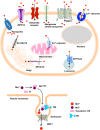Manganese-Induced Neurotoxicity: New Insights Into the Triad of Protein Misfolding, Mitochondrial Impairment, and Neuroinflammation
- PMID: 31293375
- PMCID: PMC6606738
- DOI: 10.3389/fnins.2019.00654
Manganese-Induced Neurotoxicity: New Insights Into the Triad of Protein Misfolding, Mitochondrial Impairment, and Neuroinflammation
Abstract
Occupational or environmental exposure to manganese (Mn) can lead to the development of "Manganism," a neurological condition showing certain motor symptoms similar to Parkinson's disease (PD). Like PD, Mn toxicity is seen in the central nervous system mainly affecting nigrostriatal neuronal circuitry and subsequent behavioral and motor impairments. Since the first report of Mn-induced toxicity in 1837, various experimental and epidemiological studies have been conducted to understand this disorder. While early investigations focused on the impact of high concentrations of Mn on the mitochondria and subsequent oxidative stress, current studies have attempted to elucidate the cellular and molecular pathways involved in Mn toxicity. In fact, recent reports suggest the involvement of Mn in the misfolding of proteins such as α-synuclein and amyloid, thus providing credence to the theory that environmental exposure to toxicants can either initiate or propagate neurodegenerative processes by interfering with disease-specific proteins. Besides manganism and PD, Mn has also been implicated in other neurological diseases such as Huntington's and prion diseases. While many reviews have focused on Mn homeostasis, the aim of this review is to concisely synthesize what we know about its effect primarily on the nervous system with respect to its role in protein misfolding, mitochondrial dysfunction, and consequently, neuroinflammation and neurodegeneration. Based on the current evidence, we propose a 'Mn Mechanistic Neurotoxic Triad' comprising (1) mitochondrial dysfunction and oxidative stress, (2) protein trafficking and misfolding, and (3) neuroinflammation.
Keywords: Parkinson’s disease; cell-to-cell transmission and neuroinflammation; exosome; manganese neurotoxicity; protein aggregation.
Figures





Similar articles
-
Impact of Environmental Risk Factors on Mitochondrial Dysfunction, Neuroinflammation, Protein Misfolding, and Oxidative Stress in the Etiopathogenesis of Parkinson's Disease.Int J Mol Sci. 2022 Sep 16;23(18):10808. doi: 10.3390/ijms231810808. Int J Mol Sci. 2022. PMID: 36142718 Free PMC article. Review.
-
Biotin rescues manganese-induced Parkinson's disease phenotypes and neurotoxicity.bioRxiv [Preprint]. 2023 Nov 21:2023.11.21.568033. doi: 10.1101/2023.11.21.568033. bioRxiv. 2023. Update in: Sci Signal. 2025 Jan 21;18(870):eadn9868. doi: 10.1126/scisignal.adn9868. PMID: 38045419 Free PMC article. Updated. Preprint.
-
Role of manganese in neurodegenerative diseases.J Trace Elem Med Biol. 2011 Dec;25(4):191-203. doi: 10.1016/j.jtemb.2011.08.144. Epub 2011 Oct 1. J Trace Elem Med Biol. 2011. PMID: 21963226 Free PMC article. Review.
-
Environmental neurotoxicant manganese regulates exosome-mediated extracellular miRNAs in cell culture model of Parkinson's disease: Relevance to α-synuclein misfolding in metal neurotoxicity.Neurotoxicology. 2018 Jan;64:267-277. doi: 10.1016/j.neuro.2017.04.007. Epub 2017 Apr 24. Neurotoxicology. 2018. PMID: 28450057 Free PMC article.
-
Quercetin Attenuates Manganese-Induced Neuroinflammation by Alleviating Oxidative Stress through Regulation of Apoptosis, iNOS/NF-κB and HO-1/Nrf2 Pathways.Int J Mol Sci. 2017 Sep 15;18(9):1989. doi: 10.3390/ijms18091989. Int J Mol Sci. 2017. PMID: 28914791 Free PMC article.
Cited by
-
Characterization of nonmotor behavioral impairments and their neurochemical mechanisms in the MitoPark mouse model of progressive neurodegeneration in Parkinson's disease.Exp Neurol. 2021 Jul;341:113716. doi: 10.1016/j.expneurol.2021.113716. Epub 2021 Apr 8. Exp Neurol. 2021. PMID: 33839143 Free PMC article.
-
Tackling exosome and nuclear receptor interaction: an emerging paradigm in the treatment of chronic diseases.Mil Med Res. 2024 Sep 26;11(1):67. doi: 10.1186/s40779-024-00564-1. Mil Med Res. 2024. PMID: 39327610 Free PMC article. Review.
-
Alzheimer's disease: the role of extrinsic factors in its development, an investigation of the environmental enigma.Front Neurol. 2023 Dec 6;14:1303111. doi: 10.3389/fneur.2023.1303111. eCollection 2023. Front Neurol. 2023. PMID: 38125832 Free PMC article. Review.
-
Exposing the role of metals in neurological disorders: a focus on manganese.Trends Mol Med. 2022 Jul;28(7):555-568. doi: 10.1016/j.molmed.2022.04.011. Epub 2022 May 22. Trends Mol Med. 2022. PMID: 35610122 Free PMC article. Review.
-
Trace metal elements: a bridge between host and intestinal microorganisms.Sci China Life Sci. 2023 Sep;66(9):1976-1993. doi: 10.1007/s11427-022-2359-4. Epub 2023 Jul 28. Sci China Life Sci. 2023. PMID: 37528296 Review.
References
-
- Afeseh Ngwa H., Kanthasamy A., Anantharam V., Song C., Witte T., Houk R., et al. (2009). Vanadium induces dopaminergic neurotoxicity via protein kinase C-delta dependent oxidative signaling mechanisms: relevance to etiopathogenesis of Parkinson’s disease. Toxicol. Appl. Pharmacol. 240 273–285. 10.1016/j.taap.2009.07.025 - DOI - PMC - PubMed
Publication types
LinkOut - more resources
Full Text Sources

